For wood floors, hydronic radiant heating systems are generally the best choice. They offer superior energy efficiency, consistent heat distribution, and long-term cost savings. While electric systems are easier to install, especially in existing homes, hydronic systems excel in larger spaces and whole-house applications. They're particularly compatible with engineered hardwood and denser wood species. You'll need to take into account factors like installation complexity, energy costs, and your specific flooring type. Proper moisture management and temperature control are essential to prevent wood damage. By understanding these key aspects, you'll be better equipped to make the right decision for your home.
Understanding Radiant Floor Heating Systems
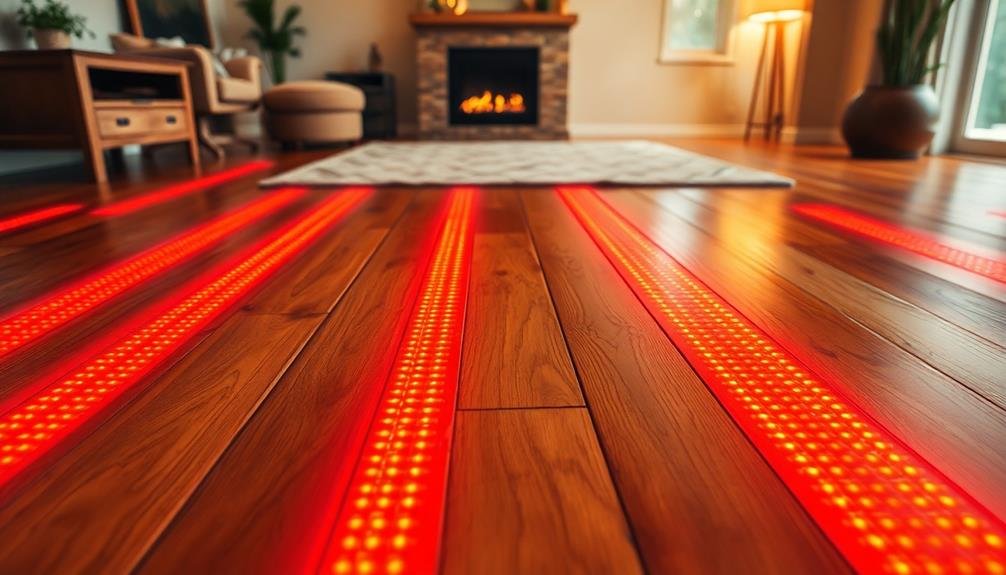
To grasp the concept of radiant floor heating systems, it's important to understand their basic function. These systems work by warming your floor directly, which then radiates heat upward into the room. Unlike traditional forced-air systems, radiant heating doesn't rely on blowing hot air through vents.
There are three main types of radiant floor heating: electric, hydronic, and air-heated. Electric systems use electric cables or mats installed beneath the floor. Hydronic systems circulate hot water through pipes, while air-heated systems pump heated air through floor cavities. Each type has its own advantages and factors to weigh.
When it comes to wood floors, you'll need to be mindful of moisture and temperature fluctuations. Radiant heating can potentially cause wood to expand, contract, or dry out if not properly controlled. That's why it's important to choose a system that offers precise temperature regulation and to select wood flooring that's compatible with radiant heat.
You'll also want to take into account factors like installation complexity, energy efficiency, and long-term costs when deciding on the best radiant heating system for your wood floors.
Benefits of Radiant Heat
Radiant heat offers a comfort revolution for homeowners with wood floors. You'll experience consistent warmth from the ground up, eliminating cold spots and drafts common with forced-air systems.
Unlike traditional heating methods, radiant heat doesn't circulate dust or allergens, improving indoor air quality and reducing respiratory issues.
Energy efficiency is another key benefit. Radiant systems typically use less energy than conventional heating, potentially lowering your utility bills.
They're also silent, operating without the noisy blowers associated with forced-air systems. This creates a more peaceful home environment.
Radiant heat provides design flexibility, as it's hidden beneath your floors. You won't need to accommodate bulky radiators or vents, freeing up wall and floor space.
It's also compatible with various floor coverings, including hardwood, tile, and carpet.
Maintenance is minimal with radiant systems. There are no filters to replace or ductwork to clean, reducing long-term costs and hassles.
Additionally, the even heat distribution can help prevent warping or splitting in wood floors, potentially extending their lifespan.
With these benefits, radiant heating can enhance both comfort and value in your home.
Types of Radiant Heating
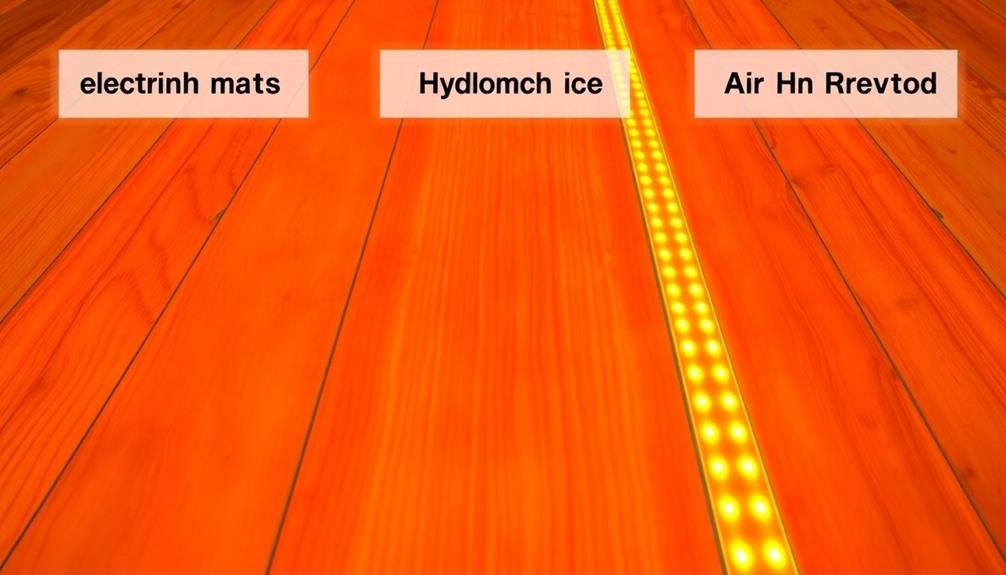
When considering radiant heating for your wood floors, you'll encounter three main types.
Electric radiant heating uses electric cables or mats installed beneath the flooring, while hydronic radiant systems circulate heated water through pipes.
Air-heated radiant floors, though less common, employ warm air to heat the floor surface.
Electric Radiant Heating
Among the various types of radiant heating systems, electric options stand out for their ease of installation and precise temperature control.
Electric radiant heating for wood floors typically involves thin heating mats or cables installed beneath the flooring. These systems are ideal for renovation projects, as they don't require significant floor height adjustments.
You'll find that electric radiant heating offers quick response times, allowing you to adjust room temperatures rapidly. It's also highly efficient, converting nearly all electrical energy into heat.
The system's zoning capabilities enable you to heat specific areas independently, potentially reducing energy consumption.
When considering electric radiant heating for your wood floors, you'll need to factor in your home's electrical capacity. These systems can draw significant power, so an electrical upgrade might be necessary.
While installation costs can be lower than hydronic systems, operating expenses may be higher depending on local electricity rates.
It's essential to choose a system compatible with your specific wood flooring type and to follow manufacturer guidelines for temperature settings to prevent damage to your floors.
Hydronic Radiant Systems
While electric systems offer certain advantages, hydronic radiant heating presents a compelling alternative for wood floors. This system uses heated water circulating through a network of tubes beneath your flooring.
It's often more energy-efficient than electric systems, especially for larger areas, as water retains heat longer than air.
You'll find that hydronic systems provide consistent, even heat distribution throughout your home. They're particularly effective with wood floors, as the gentle warmth won't cause excessive expansion or contraction of the wood.
Installation can be more complex and costly upfront, but you'll likely see lower operating costs in the long run.
One key benefit is the system's flexibility. You can use various heat sources to warm the water, including boilers, heat pumps, or even solar panels.
This versatility allows you to choose the most cost-effective or environmentally friendly option for your situation.
Maintenance is typically minimal, but it's essential to guarantee proper installation to prevent leaks.
While less common than electric systems, hydronic radiant heating can be an excellent choice for wood floors, offering efficient, comfortable warmth throughout your home.
Air-Heated Radiant Floors
Air-heated radiant floors are a lesser-known option in the world of radiant heating for wood floors. This system uses heated air to warm your flooring, typically through a network of tubes or channels beneath the surface.
While not as common as hydronic systems, air-heated radiant floors can be an effective choice for certain situations.
You'll find that air-heated systems are generally less efficient than their hydronic counterparts. They don't retain heat as well, which means they might struggle to maintain consistent temperatures in larger spaces.
However, they do have some advantages. They're often quicker to install and can be a more cost-effective option upfront.
If you're considering air-heated radiant floors for your wood flooring, keep in mind that they work best in well-insulated homes with lower heating requirements.
They're also a good choice if you're looking for a system that can provide both heating and cooling. Some air-heated systems can be reversed in summer to circulate cool air, offering year-round climate control.
When it comes to compatibility with wood floors, air-heated systems are generally safe. They operate at lower temperatures than other radiant heating options, reducing the risk of damage to your wood flooring.
Electric Vs Hydronic Systems
When choosing radiant heating for your wood floors, you'll need to take into account the differences between electric and hydronic systems.
Electric systems are typically easier to install, while hydronic systems often provide greater energy efficiency over time.
Your budget will play an essential role in the decision, as electric systems usually have lower upfront costs but higher operating expenses compared to hydronic options.
Installation Complexity Comparison
Comparing the installation complexity of electric and hydronic radiant heating systems reveals two distinct approaches.
Electric systems are generally simpler to install, especially in existing homes. You'll find they require less invasive work, as the thin heating mats or cables can be laid directly under your wood flooring. There's no need for extensive plumbing work, making it a quicker and often more cost-effective option for smaller areas or retrofits.
On the other hand, hydronic systems are more complex to install. They involve a network of pipes that circulate heated water, requiring careful planning and potentially more extensive modifications to your home's structure.
You'll need to factor in the installation of a boiler or water heater, pumps, and manifolds. While this complexity can make initial installation more challenging and time-consuming, it's often preferred for new construction or whole-house heating solutions.
The choice between the two often comes down to your specific situation. If you're looking for a straightforward, less disruptive installation, electric might be your best bet.
But if you're building new or want a highly efficient whole-house solution, the extra effort of hydronic installation could pay off in the long run.
Energy Efficiency Differences
While installation complexity is a key factor, energy efficiency often takes center stage when choosing between electric and hydronic radiant heating systems for wood floors.
Electric systems are generally less efficient than hydronic ones, as they directly convert electricity into heat. This can lead to higher operating costs, especially in regions with expensive electricity rates.
Hydronic systems, on the other hand, use hot water circulated through pipes to heat your floors. They're typically more energy-efficient because water is an excellent heat conductor and retains warmth longer than air. You'll find that hydronic systems can be up to 30% more efficient than their electric counterparts, resulting in lower energy bills over time.
However, the efficiency of both systems can be influenced by factors like insulation quality and thermostat settings.
Electric systems heat up faster and offer more precise temperature control, which can be beneficial if you're only heating specific areas or using the system intermittently.
Hydronic systems maintain a more consistent temperature and are ideal for whole-house heating.
When choosing between the two, consider your home's layout, local energy costs, and long-term usage patterns to determine which system will be most energy-efficient for your specific needs.
Cost Considerations
Although both electric and hydronic radiant heating systems offer comfort for wood floors, their cost structures differ markedly. You'll find that electric systems typically have lower upfront costs but higher operating expenses. Hydronic systems, on the other hand, require a larger initial investment but often prove more cost-effective in the long run.
When considering electric radiant heating, you're looking at easier installation and lower material costs. However, electricity rates can make ongoing expenses substantial, especially in larger spaces. Hydronic systems, while pricier to install, use more affordable energy sources like natural gas or propane, resulting in lower monthly bills.
| Cost Factor | Electric | Hydronic |
|---|---|---|
| Installation | Lower | Higher |
| Operating | Higher | Lower |
| Long-term | Variable | More economical |
You'll need to weigh your budget against long-term savings potential. If you're in a smaller space or a mild climate, electric might be more cost-effective. For larger homes or colder regions, hydronic systems could save you money over time. Consider your local energy prices, the size of your space, and your long-term plans when making your decision.
Wood Floor Compatibility
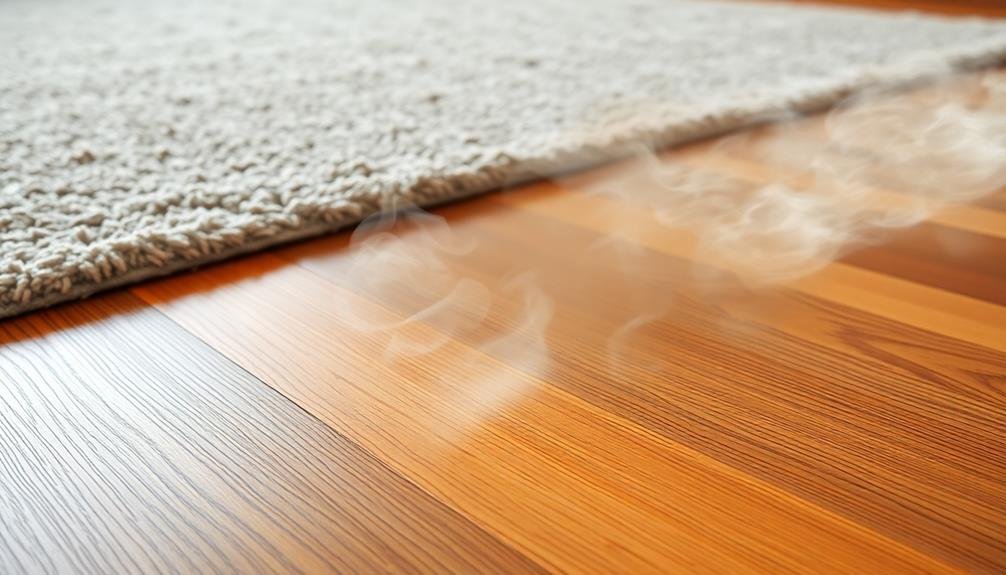
When it comes to radiant heating, not all wood floors are created equal. You'll need to take into account the type of wood flooring you have or plan to install, as some are more compatible with radiant heating systems than others.
Engineered wood floors are generally the best choice, as they're more stable and less prone to warping or shrinking due to temperature changes.
Solid hardwood floors can work with radiant heating, but you'll need to be more cautious. Narrow boards are preferable to wide planks, as they're less likely to cup or gap. Avoid using softer woods like pine, as they're more susceptible to damage from heat. Harder species like oak, maple, or walnut are better options.
Regardless of the wood type, it's essential to maintain proper humidity levels in your home. Aim for a relative humidity between 35% and 55% to prevent excessive expansion or contraction of the wood.
You should also think about using a wood flooring with a lower moisture content, ideally around 6-8%, to minimize potential issues. Always consult with both your flooring manufacturer and radiant heating system installer to guarantee compatibility and proper installation techniques.
Installation Process and Costs
You'll find that installing radiant heating for wood floors involves a specific step-by-step process, which we'll outline for you shortly.
It's essential to understand these steps before starting the project, as proper installation guarantees peak performance and longevity.
We'll also provide a cost comparison analysis to help you budget effectively and choose the most suitable radiant heating system for your wood floors.
Step-By-Step Installation Guide
To commence the journey of installing radiant heating for wood floors, it's essential to understand the step-by-step process and associated costs.
Begin by evaluating your subfloor and ensuring it's level and clean. Next, lay down a vapor barrier to protect against moisture. Install insulation panels to improve heat retention and efficiency.
For electric systems, roll out the heating mats or cables according to the manufacturer's instructions. For hydronic systems, install the tubing in a serpentine pattern. Secure the heating elements in place and connect them to the power source or boiler.
Pour a layer of self-leveling compound over the heating elements to create a smooth surface. Once dry, install your chosen wood flooring according to the manufacturer's guidelines. Finally, connect the thermostat and test the system.
Costs vary depending on the type of system and square footage. Electric systems typically range from $8 to $15 per square foot, while hydronic systems can cost between $6 and $20 per square foot.
Factor in additional expenses for professional installation, which can add $2 to $4 per square foot to your total costs.
Cost Comparison Analysis
Understanding the cost implications of different radiant heating systems for wood floors is vital for making an informed decision. Electric systems typically have lower upfront costs, ranging from $5 to $7 per square foot for materials and installation. However, they're more expensive to operate long-term due to higher electricity rates.
Hydronic systems, while pricier to install at $6 to $15 per square foot, offer lower operating costs, especially if you have an efficient boiler. When comparing costs, consider your home's size and layout. Larger spaces may benefit more from hydronic systems' lower operating costs, while smaller areas might find electric systems more cost-effective.
Don't forget to factor in potential energy savings and increased home value. Radiant heating can reduce your overall energy consumption by 25-30% compared to forced-air systems.
Installation costs vary depending on whether you're retrofitting an existing floor or installing in new construction. Retrofitting is generally more expensive due to the need to remove and replace existing flooring. New construction installations are often more cost-effective, as the system can be integrated during the building process.
Remember to get multiple quotes from licensed contractors to guarantee you're getting the best value for your investment.
Energy Efficiency Considerations
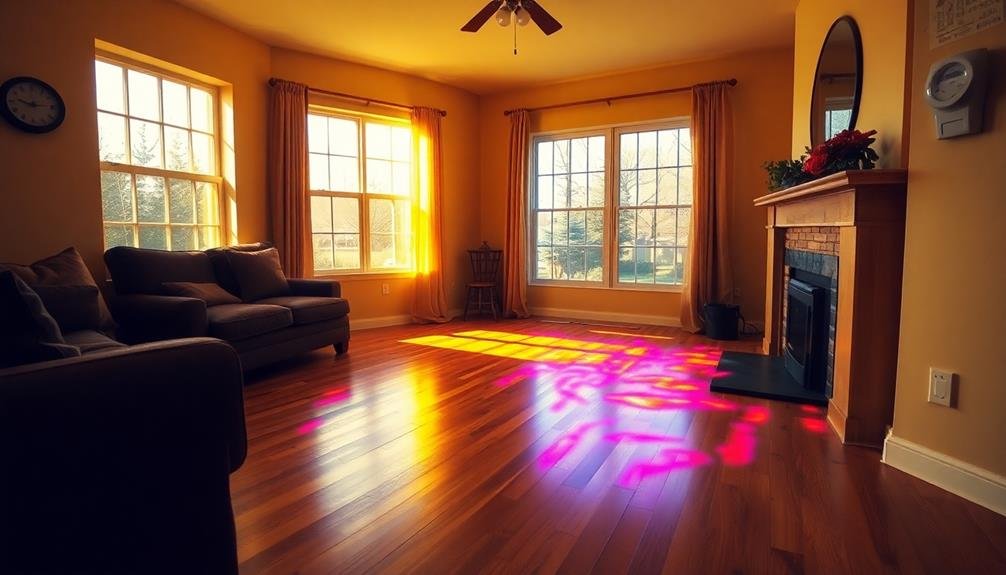
When considering radiant heating for wood floors, energy efficiency should be at the forefront of your decision-making process.
Radiant heating systems are generally more efficient than traditional forced-air systems, but there are still variations among different types.
Electric radiant heating is 100% efficient at the point of use, converting all electricity into heat. However, the overall efficiency depends on how your electricity is generated. If you have access to renewable energy sources, electric systems can be highly efficient.
Hydronic radiant heating systems, which use hot water, are typically more energy-efficient in the long run. They can be powered by various heat sources, including high-efficiency boilers, heat pumps, or solar thermal systems. This flexibility allows you to choose the most efficient option for your area and budget.
When selecting a radiant heating system, look for models with programmable thermostats and zoning capabilities. These features allow you to heat only the areas you're using and adjust temperatures based on your schedule, further improving energy efficiency.
Consider the insulation of your home as well. Proper insulation will help retain heat and reduce energy consumption, maximizing the efficiency of your radiant heating system.
Moisture and Humidity Concerns
Addressing moisture and humidity concerns is essential when installing radiant heating under wood floors. Wood naturally expands and contracts with changes in moisture content, and radiant heating can affect the humidity levels in your home. To prevent warping, cracking, or other damage to your wood floors, you'll need to take specific precautions.
First, verify your wood flooring is properly acclimated to your home's environment before installation. This process typically takes 1-2 weeks. During this time, maintain consistent temperature and humidity levels in the room where the flooring will be installed.
Once your radiant heating system is in place, monitor and control humidity levels in your home. Aim for a relative humidity between 35% and 55%. You can achieve this by:
- Using a whole-house humidifier or dehumidifier
- Installing moisture barriers beneath the flooring
- Choosing engineered wood flooring, which is more stable than solid hardwood
Regularly inspect your wood floors for signs of moisture-related issues, such as cupping or crowning. If you notice any problems, adjust your heating and humidity control systems promptly to prevent further damage.
Maintenance and Longevity
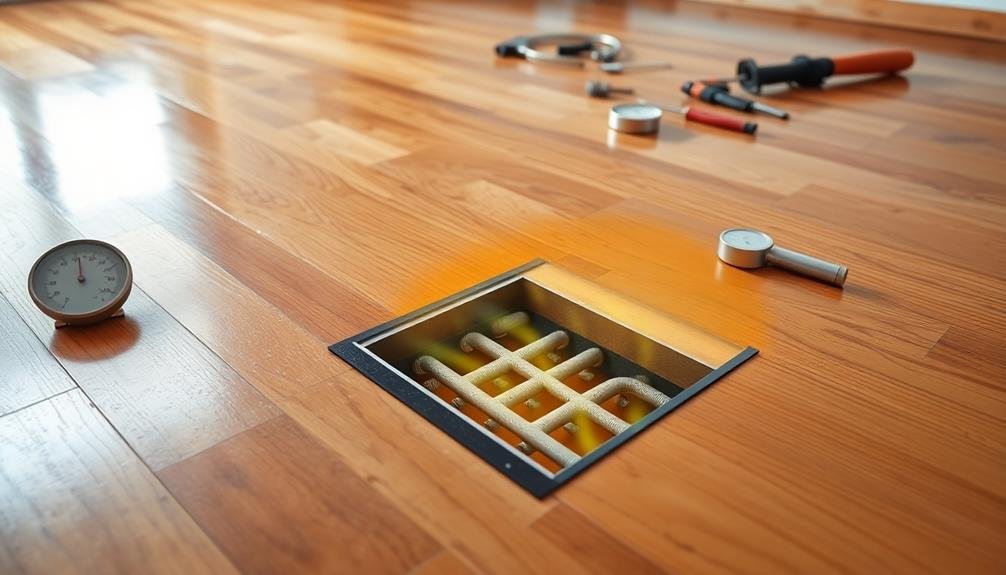
Proper maintenance of your radiant heating system and wood flooring is essential for ensuring their longevity. Regular inspections of your radiant heating components, including pumps, valves, and thermostats, will help prevent unexpected breakdowns.
You should also flush the system annually to remove any sediment buildup that could reduce efficiency.
For your wood floors, maintain a consistent indoor temperature and humidity level to prevent warping or gaps. Use a humidifier during dry months to keep moisture levels stable.
Clean your floors regularly with a damp mop, avoiding excess water that could seep into the wood. Apply a protective finish every few years to guard against scratches and wear.
Be mindful of heavy furniture placement, using felt pads to distribute weight evenly and prevent dents. If you notice any issues with your flooring or heating system, address them promptly to avoid more extensive damage.
With proper care, your radiant heating system can last 20-30 years, while well-maintained wood floors can endure for generations. Remember, investing time in maintenance now will save you money and headaches in the long run.
Radiant Heat Flooring Materials
Choosing the right flooring material is vital for maximizing the efficiency of your radiant heating system. Wood floors are popular choices, but not all types are suitable. Engineered hardwood is your best bet, as it's more stable and less prone to warping than solid wood. It also conducts heat better, guaranteeing even distribution throughout your space.
When selecting wood flooring for radiant heat, consider these factors:
- Wood species: Opt for dense hardwoods like oak, maple, or walnut, which conduct heat efficiently.
- Plank thickness: Thinner planks (3/8 to 1/2 inch) allow better heat transfer than thicker ones.
- Installation method: Choose a floating floor installation for easier maintenance and repair.
Other materials that work well with radiant heating include luxury vinyl planks (LVP) and ceramic tiles. LVP is an excellent alternative to wood, offering durability and moisture resistance.
Ceramic tiles are highly conductive and perfect for bathrooms or kitchens. Remember, regardless of the material you choose, proper installation is vital for peak performance. Always consult with a professional to confirm your radiant heating system and flooring are compatible and installed correctly.
Temperature Control and Zoning
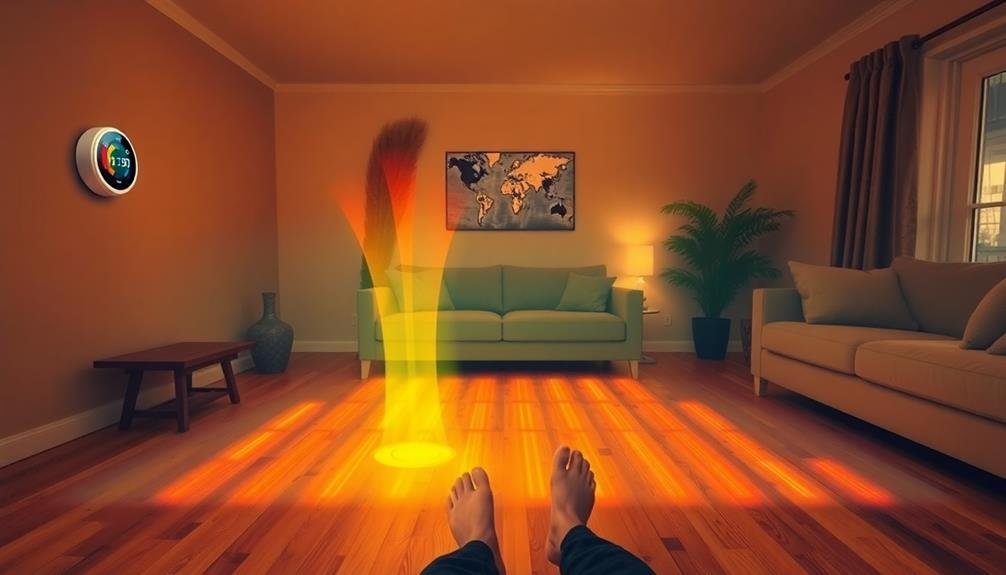
Once you've selected the ideal flooring material for your radiant heating system, it's time to reflect on temperature control and zoning. Effective temperature management is vital for maintaining comfort and protecting your wood floors from damage due to excessive heat or humidity fluctuations.
Modern radiant heating systems offer sophisticated control options. You'll want to invest in a programmable thermostat that allows you to set different temperatures for various times of day. This enables you to lower the heat when you're away or sleeping, saving energy and money.
Zoning is another fundamental aspect to evaluate. By dividing your home into separate heating zones, you can tailor temperatures to specific areas. This is particularly useful if you have rooms that are used less frequently or require different temperatures.
For wood floors, it's important to maintain consistent temperatures across zones to prevent warping or gaps between planks. Some advanced systems even offer smartphone integration, allowing you to adjust your home's temperature remotely. This feature is handy for vacation homes or if your schedule changes unexpectedly.
Professional Vs DIY Installation
The decision between professional and DIY installation can greatly impact the success of your radiant heating system for wood floors.
Professional installation offers expertise, precision, and warranty coverage, ensuring your system is properly integrated with your wood flooring. Experts can navigate complex issues like proper insulation, electrical requirements, and system compatibility.
DIY installation may seem cost-effective, but it requires extensive knowledge of electrical systems, flooring, and radiant heating technology. You'll need to carefully follow manufacturer instructions and local building codes. Mistakes can lead to inefficient heating, damaged flooring, or safety hazards.
Consider these factors when deciding:
- Complexity of your project
- Your skill level and available time
- Budget constraints
If you're confident in your abilities and have a simple layout, DIY might be feasible.
However, for most homeowners, professional installation is the safer choice. It guarantees proper installation, ideal performance, and peace of mind.
Frequently Asked Questions
Can Radiant Heating Systems Be Used With Engineered Wood Floors?
Yes, you can use radiant heating with engineered wood floors. They're more stable than solid wood and handle temperature changes better. However, you'll need to follow manufacturer guidelines and maintain proper humidity levels to prevent damage.
How Does Radiant Heating Affect Indoor Air Quality?
Radiant heating can improve your indoor air quality. You'll experience less dust circulation and reduced allergens. It doesn't dry out the air like forced-air systems, maintaining comfortable humidity levels. Plus, it's silent, so you'll enjoy a quieter environment.
Are There Any Specific Wood Species That Work Best With Radiant Heating?
You'll find that engineered hardwoods, like oak, maple, and ash, work best with radiant heating. They're stable and resist warping. Avoid softer woods like pine. Remember to keep your wood floor's thickness under 3/4 inch for ideal heat transfer.
Can Radiant Heating Systems Be Integrated With Smart Home Technologies?
Yes, you can integrate radiant heating systems with smart home technologies. You'll be able to control your heating remotely, set schedules, and optimize energy usage. Smart thermostats and mobile apps make it easy to manage your radiant heating efficiently.
How Does Radiant Heating Impact Resale Value of a Home?
You'll likely see a boost in your home's resale value with radiant heating. It's an energy-efficient, comfortable feature that appeals to many buyers. You're investing in a luxury that can set your property apart from others.
In Summary
You've now got a solid understanding of radiant heating options for wood floors. Whether you choose electric or hydronic systems, you'll enjoy efficient, comfortable warmth. Remember to take into account your specific needs, budget, and floor type when deciding. Don't forget about proper installation and maintenance to guarantee longevity. With the right radiant heating system, you'll transform your wood floors into a cozy, inviting space that you'll love for years to come.



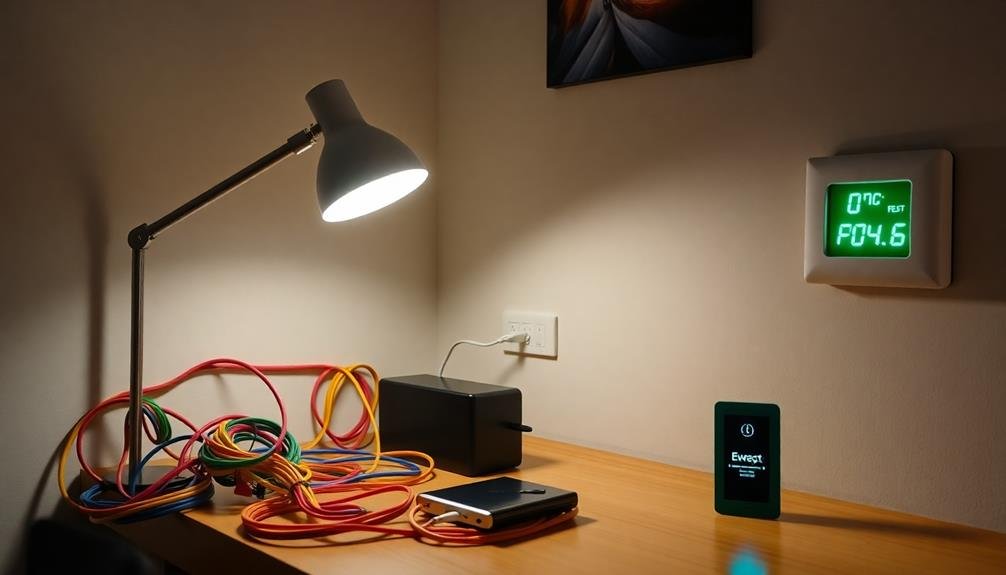

Leave a Reply